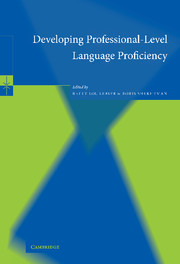Book contents
- Frontmatter
- Contents
- Notes on contributors
- Foreword
- Acknowledgments
- I Principles, practices, and theory
- II Programs
- 3 Contexts for advanced foreign language learning: a report on an immersion institute
- 4 Bridging the gap between language for general purposes and language for work: an intensive Superior-level language/skill course for teachers, translators, and interpreters
- 5 Learning Chinese in China: programs for developing Superior- to Distinguished-level Chinese language proficiency in China and Taiwan
- 6 Developing professional-level oral proficiency: the Shekhtman Method of Communicative teaching
- 7 The LangNet “Reading to the Four” Project: applied technology at higher levels of language learning
- 8 In the quest for the Level 4+ in Arabic: training Level 2–3 learners in independent reading
- 9 Teaching high-level writing skills in English at a Danish university
- 10 Heritage speakers as learners at the Superior level: differences and similarities between Spanish and Russian student populations
- 11 Teaching Russian language teachers in eight summer Institutes in Russian language and culture
- III Learners and users
- References
- Index
7 - The LangNet “Reading to the Four” Project: applied technology at higher levels of language learning
Published online by Cambridge University Press: 03 December 2009
- Frontmatter
- Contents
- Notes on contributors
- Foreword
- Acknowledgments
- I Principles, practices, and theory
- II Programs
- 3 Contexts for advanced foreign language learning: a report on an immersion institute
- 4 Bridging the gap between language for general purposes and language for work: an intensive Superior-level language/skill course for teachers, translators, and interpreters
- 5 Learning Chinese in China: programs for developing Superior- to Distinguished-level Chinese language proficiency in China and Taiwan
- 6 Developing professional-level oral proficiency: the Shekhtman Method of Communicative teaching
- 7 The LangNet “Reading to the Four” Project: applied technology at higher levels of language learning
- 8 In the quest for the Level 4+ in Arabic: training Level 2–3 learners in independent reading
- 9 Teaching high-level writing skills in English at a Danish university
- 10 Heritage speakers as learners at the Superior level: differences and similarities between Spanish and Russian student populations
- 11 Teaching Russian language teachers in eight summer Institutes in Russian language and culture
- III Learners and users
- References
- Index
Summary
While multimedia language-learning opportunities, including those that are Internet-based, have proliferated in recent years, little or nothing of an instructional nature has been available for the highly advanced (SD) language learner. The “Reading to the Four” (R4) Project, currently being developed for the LangNet website of the National Foreign Language Center (NFLC), is intended to begin filling this void.
The LangNet Initiative
The LangNet Initiative (Brecht and Walton, 1993) is a complex, many-faceted effort that shares expertise and learning resources in order to enhance and democratize access to effective language-learning opportunities. The project discussed in this chapter is a seminal component in that it addresses learning needs that are underserved in almost every setting – those of the most advanced learners of languages critical to the national interest of the USA, for whom pre-existing learning resources are scarce and often of poor quality.
Progressive development and elaboration throughout the 1990s of Brecht and Walton's proposed LangNet model led to a pilot project in four Less Commonly Taught Languages (LCTLs) and development of a first version of a website and database. At that time, NFLC, in collaboration with more than a dozen national foreign language teacher associations, began to identify categories of learners in each of the languages whose needs were underserved, initially focusing on the academic sector. Editorial Boards, appointed by the associations, located high-quality learning resources, which they catalogued in a searchable database.
- Type
- Chapter
- Information
- Developing Professional-Level Language Proficiency , pp. 141 - 155Publisher: Cambridge University PressPrint publication year: 2002
- 1
- Cited by



